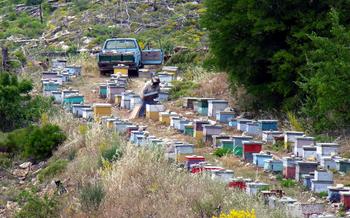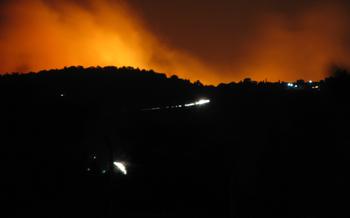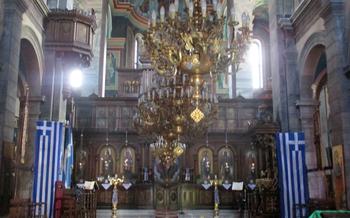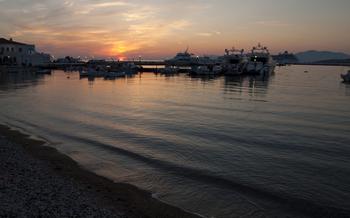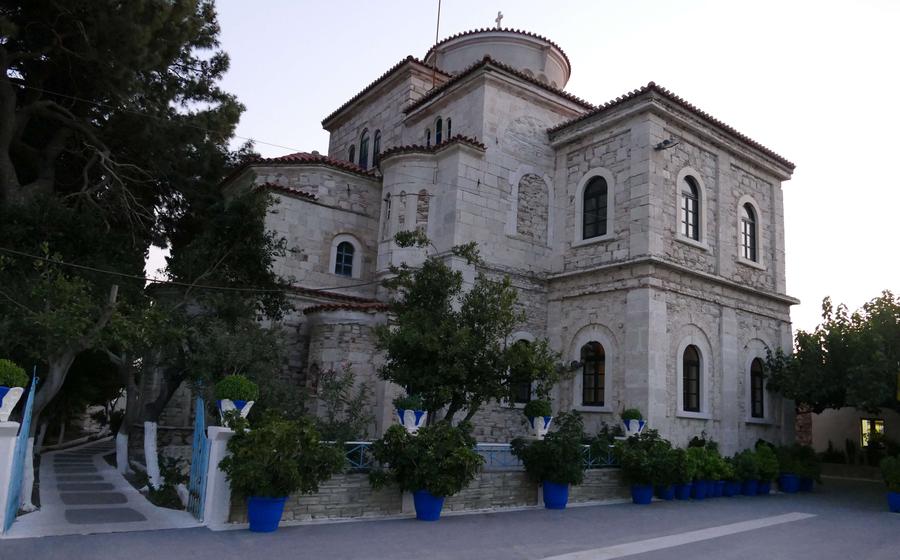
The Church of the Transfiguration
- The Path to the Church
- The History of the Church
- The Interior of the Church
- The Views from the Church
- The Festival of the Transfiguration
- The Pilgrimage to the Church
- The Church's Role in the Community
- The Symbolism of the Church
- The Church's Architectural Features
- The Restoration and Preservation Efforts
- Local Legends and Myths
- The Church's Contribution to Tourism
- The Church as a Place of Reflection
- Personal Anecdote
- Insider Tip:
The Path to the Church
The path leading to the Church of the Transfiguration is a journey in itself, offering breathtaking views and a chance to immerse yourself in the natural beauty of Samos. As you embark on this picturesque trail, prepare to be mesmerized by the stunning scenery that unfolds before you. The path meanders through a verdant landscape, with lush greenery, colorful wildflowers, and fragrant herbs carpeting the ground beneath your feet. The air is filled with the sweet aroma of blooming plants and the harmonious sounds of birdsong, creating a symphony of nature that accompanies you along the way.
The level of difficulty for the hike is considered moderate, with some sections requiring a bit of effort due to the uneven terrain. However, the well-maintained path ensures a safe and enjoyable experience for hikers of all levels. The distance from Manolates to the church is approximately 3 kilometers, and the hike typically takes around 45 minutes to an hour, depending on your pace and the number of photo stops you make along the way.
Before embarking on your hike, it's essential to wear comfortable shoes with good traction, as the path can be slippery in certain areas. Additionally, bring plenty of water, especially if you're visiting during the hot summer months. Along the trail, you'll find several resting spots where you can take a break, admire the scenery, and soak in the tranquility of your surroundings.
As I ventured along the path, I couldn't help but feel a sense of anticipation growing within me. The closer I got to the church, the more I felt drawn to its allure, eager to discover the secrets and stories that awaited me within its sacred walls.
The History of the Church
The Church of the Transfiguration, also known as the Metamorphosis tou Sotiros, holds a significant place in the religious and cultural history of Samos. According to local tradition, the church was founded by the Byzantine Emperor Constantine IX Monomachos in the 11th century. The emperor, known for his piety and devotion to Christianity, is said to have been inspired to build the church after a miraculous vision of the Transfiguration of Jesus on Mount Tabor.
The church's architectural style is a testament to the rich Byzantine heritage of Samos. Constructed from local stone and featuring intricate carvings and decorative elements, the church exudes an aura of antiquity and grandeur. The interior of the church is adorned with stunning frescoes and icons depicting biblical scenes and the lives of saints. These artworks, dating back centuries, offer a glimpse into the religious and artistic traditions of the Byzantine period.
The Church of the Transfiguration has long been a place of worship and pilgrimage for the people of Samos. Throughout the centuries, it has served as a spiritual center for the local community, where religious ceremonies, festivals, and celebrations have been held. The church's enduring significance as a sacred site has made it a beloved landmark and a symbol of faith for generations of Samiotes.
The Interior of the Church
The interior of the Church of the Transfiguration is a sight to behold. The walls are adorned with exquisite Byzantine-style frescoes that depict scenes from the Bible. The iconography is vibrant and expressive, bringing the stories to life. The ceiling is adorned with a beautiful mosaic of Christ Pantocrator, surrounded by angels and saints. The altar is intricately carved with scenes from the life of Jesus, and the iconostasis is adorned with icons of the Virgin Mary, Jesus Christ, and various saints. The atmosphere inside the church is awe-inspiring and serene, creating a sense of deep spirituality.
Personal anecdote:
During my visit to the church, I was particularly struck by the beauty of the icon of the Virgin Mary. Her eyes seemed to follow me as I moved around the church, and I felt a sense of peace and tranquility wash over me. I sat down on a pew and spent some time contemplating the icon, reflecting on her role as a mother and protector. It was a truly moving experience that left a lasting impression on me.
The Views from the Church
The Church of the Transfiguration offers breathtaking panoramic views of the Aegean Sea and the surrounding landscape. From the church's elevated position, visitors can gaze out over the azure waters, dotted with sailboats and fishing vessels, and admire the verdant slopes and rocky cliffs that hug the coastline. The views are particularly stunning at sunset, when the sky erupts in a kaleidoscope of colors, casting a golden glow on the sea and the surrounding landscape.
Standing on the church's terrace, one feels a sense of serenity and tranquility. The gentle sea breeze caresses one's skin, carrying the sound of waves crashing against the shore. The air is filled with the fragrance of wildflowers and the chirping of birds. It is the perfect spot to relax and soak in the beauty of the island.
For photography enthusiasts, the Church of the Transfiguration presents an abundance of opportunities to capture stunning images. The panoramic vistas, combined with the church's unique architecture and the natural beauty of the surroundings, create a picturesque backdrop for unforgettable photographs. Whether you are an amateur or a professional photographer, you will find endless inspiration in this idyllic setting.
Personal anecdote:
On my visit to the church, I spent a considerable amount of time simply standing on the terrace and admiring the views. The beauty of the landscape was awe-inspiring, and I couldn't help but feel a sense of peace and tranquility wash over me. I snapped a few photographs, but I found that they couldn't truly capture the majesty of what I was witnessing. It was a moment that I will cherish forever.
The Festival of the Transfiguration
Every year on August 6th, the Church of the Transfiguration comes alive with the annual Festival of the Transfiguration. This vibrant celebration honors the patron saint of the church and showcases the rich cultural traditions of Samos. The festival kicks off with a solemn religious service followed by a lively procession carrying the icon of the Transfiguration through the village streets. The air fills with the sounds of traditional Greek music, as locals and visitors alike dance and sing in joyous celebration.
Food stalls offering delicious local delicacies line the village square, tempting visitors with mouthwatering aromas. The festival is a perfect opportunity to indulge in traditional Greek cuisine, such as souvlaki, moussaka, and baklava. As the sun begins to set, the festivities culminate in a spectacular fireworks display that illuminates the night sky, leaving visitors in awe and wonder.
The Pilgrimage to the Church
The Church of the Transfiguration is not just a historical site but also a significant pilgrimage destination. Every year, during the feast of the Transfiguration on August 6th, thousands of pilgrims from all over Greece and beyond flock to the church to celebrate and seek blessings.
The pilgrimage to the church is a deeply spiritual experience for many. Pilgrims come with their prayers and petitions, seeking divine intervention and guidance. The church is believed to possess miraculous powers, and stories of healings and answered prayers are often shared among the faithful.
For pilgrims, the journey to the church is as important as the destination itself. Many choose to walk the entire distance from their homes to the church, a journey that can take several days or even weeks. Along the way, pilgrims often stop at other churches and monasteries, seeking blessings and guidance before reaching their final destination.
The atmosphere at the church during the festival is electric. The air is filled with the sound of chanting, music, and prayers. Pilgrims gather in the courtyard, lighting candles and offering incense to the icons of Jesus Christ and the Prophet Elijah, who is also venerated at the church.
The pilgrimage to the Church of the Transfiguration is a testament to the deep faith and devotion of the Greek people. It is an opportunity for pilgrims to connect with their spirituality, seek divine guidance, and experience the power of community and shared belief.
The Church's Role in the Community
The Church of the Transfiguration is not just a religious site; it is also an integral part of the local community. The church serves as a gathering place for villagers to celebrate religious holidays, hold community events, and socialize. The community takes great pride in maintaining and preserving the church, organizing regular cleaning and maintenance activities. The church also plays a role in fostering a sense of community, providing support and guidance to villagers in times of need.
Personal anecdote:
During my visit to the church, I had the opportunity to interact with several local residents who were actively involved in maintaining the church. They spoke with great passion about the importance of the church to the community and the role it plays in preserving their cultural heritage. I was struck by their sense of ownership and pride in the church, and it was evident that the church was not just a building to them but a symbol of their community's identity and values.
The Symbolism of the Church
The Church of the Transfiguration stands as a profound symbol of faith, hope, and transformation. Its very name, "Transfiguration," evokes the miraculous event described in the Gospels, where Jesus' appearance was transformed, radiating divine light. This symbolism resonates deeply with visitors, who often find solace and inspiration within its sacred walls.
The church's location atop a hill overlooking the Aegean Sea further enhances its symbolic meaning. Perched between the heavens and the earth, it represents a bridge between the spiritual and the physical realms. The panoramic views from the church invite visitors to contemplate the vastness of the universe and their place within it.
Moreover, the church's architecture and iconography contribute to its symbolic significance. The intricate frescoes and mosaics depict scenes from the Bible, reminding visitors of the transformative power of faith. The domed roof, a common feature in Byzantine architecture, symbolizes the heavens and the celestial realm.
For many visitors, the Church of the Transfiguration becomes a place of profound reflection and spiritual growth. Its serene atmosphere and rich symbolism create an ideal setting for contemplation, introspection, and a deeper connection with the divine.
Personal Anecdote:
During my visit to the church, I was struck by its powerful symbolism. As I stood before the iconostasis, adorned with exquisite Byzantine icons, I felt a sense of awe and reverence. The stories depicted in the icons reminded me of the transformative power of faith and the possibility of spiritual renewal. The church's location, perched high above the sea, further enhanced the experience, creating a sense of being closer to the heavens.
The Church's Architectural Features
The Church of the Transfiguration is a stunning example of Byzantine and local architectural styles. Its unique features include its domed roof, which is supported by four massive pillars, and its intricate stone carvings that adorn the exterior walls. The church's interior is equally impressive, with its vaulted ceilings, marble floors, and beautiful frescoes that depict scenes from the Bible.
One of the most striking features of the church is its domed roof. The dome is constructed of brick and mortar, and it is supported by four massive pillars that are positioned at each corner of the church. The dome is topped by a cross, which symbolizes the Christian faith.
The exterior walls of the church are adorned with intricate stone carvings. These carvings depict a variety of scenes, including biblical stories, saints, and animals. The carvings are a testament to the skill of the craftsmen who built the church.
The interior of the church is just as impressive as the exterior. The vaulted ceilings are supported by a series of arches, which create a sense of space and grandeur. The marble floors are inlaid with intricate patterns, and the walls are covered in beautiful frescoes. The frescoes depict scenes from the Bible, and they are a testament to the artistic talent of the monks who created them.
The Restoration and Preservation Efforts
The Church of the Transfiguration has undergone several restoration and preservation efforts throughout its history to maintain its historical and cultural significance. In the early 20th century, the church's roof was in dire need of repair, and extensive work was undertaken to restore it to its original condition. Skilled craftsmen used traditional techniques and materials to ensure the authenticity of the repairs, preserving the church's architectural integrity.
In recent years, the local community and various organizations have played a crucial role in preserving the church. Regular maintenance and cleaning are carried out to protect the structure from the elements and ensure its longevity. Furthermore, ongoing efforts are made to document and preserve the church's history, including the collection of oral histories from local residents who have personal connections to the church.
Personal Anecdote:
During my visit to the church, I had the opportunity to speak with a local historian who was deeply involved in the restoration efforts. He shared fascinating stories about the challenges they faced in sourcing materials and maintaining the church's authenticity. It was inspiring to learn about the dedication and passion of the community in preserving this sacred site for future generations.
Local Legends and Myths
The Church of the Transfiguration is steeped in local legends and myths that have been passed down through generations. One popular tale tells of a young shepherd who stumbled upon a hidden cave while tending his flock. Inside the cave, he discovered a miraculous icon of the Transfiguration, which began to glow with a divine light. Word of the miraculous icon spread throughout the village, and soon pilgrims began to flock to the site, seeking blessings and divine intervention.
Another legend associated with the church speaks of a terrible drought that once plagued the island. The villagers, desperate for rain, gathered at the church and prayed fervently for divine assistance. Miraculously, a torrential downpour began, saving the island from ruin. To this day, the villagers believe that the church holds a special power to intercede on their behalf and bring about miracles.
The Church's Contribution to Tourism
The Church of the Transfiguration is not just a religious site but also a significant tourist attraction in Samos. Its unique architecture, historical significance, and stunning views attract visitors from all over the world. The influx of tourists has had a positive impact on the local economy, creating jobs and boosting revenue for businesses such as hotels, restaurants, and souvenir shops. However, it is crucial to maintain a balance between promoting tourism and preserving the sanctity of the church. Visitors should be respectful of the religious significance of the site and avoid any behavior that could be considered disrespectful or disruptive. Responsible tourism practices, such as adhering to the dress code and avoiding loud noises, help ensure that the church remains a place of peace and tranquility for all visitors.
Personal anecdote:
During my visit to the church, I had the opportunity to interact with several tourists from different countries. They expressed their awe at the beauty of the church and the breathtaking views from its courtyard. Many of them mentioned that they had specifically come to Samos to see the church, and their visit had exceeded their expectations. It was heartening to see how the church was not only a place of spiritual significance but also a catalyst for promoting cultural exchange and understanding among people from diverse backgrounds.
The Church as a Place of Reflection
Amidst the stunning beauty of Samos, the Church of the Transfiguration stands as a sanctuary of tranquility and peace. As you step inside its ancient walls, a sense of serenity envelops you, inviting you to shed the distractions of the outside world. The church's simple yet elegant interior, bathed in soft, golden light, creates an atmosphere conducive to contemplation and reflection.
Whether you are a devout believer seeking spiritual connection or simply a traveler in search of inner peace, the Church of the Transfiguration offers a haven for reflection. Within its sacred space, you can pause, take a deep breath, and allow your mind to wander freely. Let the beauty of the surroundings, the soft murmur of prayers, and the gentle sway of the incense transport you to a realm of introspection and self-discovery.
For many visitors, the church provides an opportunity to reconnect with their spirituality and explore the deeper questions of life. Whether you are seeking solace, guidance, or simply a moment of quiet contemplation, the Church of the Transfiguration welcomes you with open arms. As you sit in silent meditation, surrounded by centuries of history and faith, you may find yourself experiencing a profound sense of connection with the divine, whatever that may mean to you.
Personal Anecdote
During my visit to the Church of the Transfiguration, I sought a moment of respite from the bustling crowds and overwhelming beauty of Samos. Stepping inside the church, I was immediately struck by the palpable sense of peace that permeated the air. I found a quiet corner and sat down, allowing myself to be enveloped by the tranquility of my surroundings.
As I sat there, my mind drifted to the countless pilgrims and visitors who had come to this sacred place before me. I imagined their hopes, fears, and dreams, and the solace they must have found within these walls. The church's simple beauty and the soft glow of the candles seemed to invite reflection and introspection, and I couldn't help but feel a sense of connection to something greater than myself.
In that moment of quiet contemplation, I found a renewed sense of peace and clarity. The Church of the Transfiguration had become more than just a historical landmark; it had become a place of profound spiritual significance, where I could come to seek solace, find guidance, and connect with my inner self.
Insider Tip:
Make the Most of Your Visit: Visiting the Church of the Transfiguration is a unique and enriching experience. To make the most of your visit, consider planning your trip for the early morning or late afternoon to avoid the midday heat and capture the most stunning light for photography. Dress respectfully, as the church is a sacred site, and ensure comfortable footwear for the hike. The path to the church is well-maintained, but sturdy shoes will provide better support.
Combine Your Visit: After exploring the church, enhance your experience by visiting nearby attractions. The village of Manolates itself offers charming cafes and tavernas where you can savor traditional Greek cuisine and immerse yourself in the local culture. For a breathtaking panoramic view, ascend to Mount Kerkis, the highest peak on Samos. The mountain offers scenic hiking trails and unforgettable vistas of the Aegean Sea.
Capture the Beauty: The Church of the Transfiguration and its surroundings present endless photographic opportunities. Capture the panoramic views, the intricate details of the church's architecture, and the surrounding natural beauty. For a unique perspective, hike to the nearby hilltop of Profitis Ilias, where you'll find an abandoned monastery offering breathtaking views of the church and the Aegean Sea.
Personal Anecdote: During my visit to the Church of the Transfiguration, I stumbled upon a hidden gem—a small garden nestled behind the church. It was a tranquil oasis filled with fragrant flowers, colorful butterflies, and the gentle sound of a nearby stream. I spent a few moments sitting in the garden, marveling at the beauty of nature and reflecting on the church's spiritual significance. It was an unexpected and deeply moving experience that enriched my overall visit.
